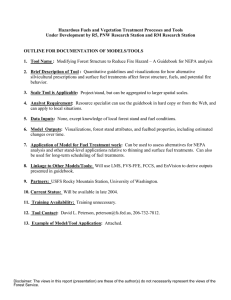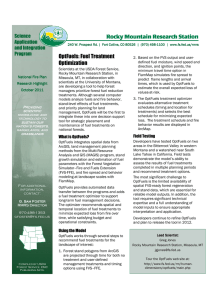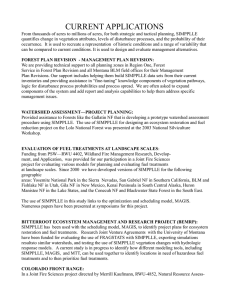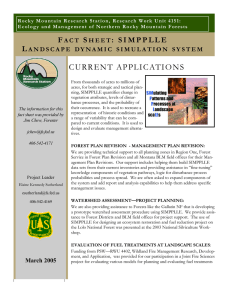Enclosure 3A - Project Summary Form
advertisement
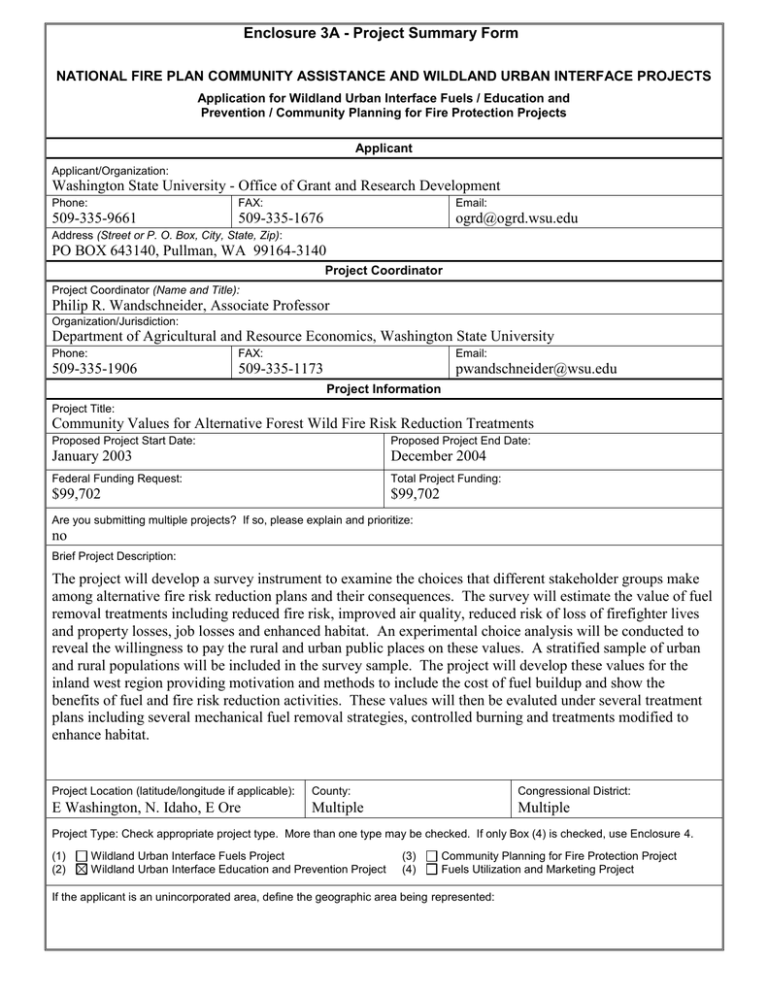
Enclosure 3A - Project Summary Form NATIONAL FIRE PLAN COMMUNITY ASSISTANCE AND WILDLAND URBAN INTERFACE PROJECTS Application for Wildland Urban Interface Fuels / Education and Prevention / Community Planning for Fire Protection Projects Applicant Applicant/Organization: Washington State University - Office of Grant and Research Development Phone: FAX: Email: 509-335-9661 509-335-1676 ogrd@ogrd.wsu.edu Address (Street or P. O. Box, City, State, Zip): PO BOX 643140, Pullman, WA 99164-3140 Project Coordinator Project Coordinator (Name and Title): Philip R. Wandschneider, Associate Professor Organization/Jurisdiction: Department of Agricultural and Resource Economics, Washington State University Phone: FAX: Email: 509-335-1906 509-335-1173 pwandschneider@wsu.edu Project Information Project Title: Community Values for Alternative Forest Wild Fire Risk Reduction Treatments Proposed Project Start Date: Proposed Project End Date: January 2003 December 2004 Federal Funding Request: Total Project Funding: $99,702 $99,702 Are you submitting multiple projects? If so, please explain and prioritize: no Brief Project Description: The project will develop a survey instrument to examine the choices that different stakeholder groups make among alternative fire risk reduction plans and their consequences. The survey will estimate the value of fuel removal treatments including reduced fire risk, improved air quality, reduced risk of loss of firefighter lives and property losses, job losses and enhanced habitat. An experimental choice analysis will be conducted to reveal the willingness to pay the rural and urban public places on these values. A stratified sample of urban and rural populations will be included in the survey sample. The project will develop these values for the inland west region providing motivation and methods to include the cost of fuel buildup and show the benefits of fuel and fire risk reduction activities. These values will then be evaluted under several treatment plans including several mechanical fuel removal strategies, controlled burning and treatments modified to enhance habitat. Project Location (latitude/longitude if applicable): County: Congressional District: E Washington, N. Idaho, E Ore Multiple Multiple Project Type: Check appropriate project type. More than one type may be checked. If only Box (4) is checked, use Enclosure 4. (1) (2) Wildland Urban Interface Fuels Project Wildland Urban Interface Education and Prevention Project (3) (4) Community Planning for Fire Protection Project Fuels Utilization and Marketing Project If the applicant is an unincorporated area, define the geographic area being represented: Enclosure 3B (Page 1 of 3) - Project Narrative Description Applications for funding must include a narrative response that describes the proposal. Please do not submit responses longer than one page, single space, 12-pitch font. Describe project including, but not limited to: project location Address these project implementation items as anticipated outcomes applicable: measures and reporting interagency partners project relationship to community or natural landscape fire plans project time frames and income specify types of activities and equipment used amount or extent of actions (acres, number of homes, etc) environmental, cultural and historical resource requirements It is generally recognized that catastrophic fire risks are rising in the inland west. Many values associated with fire risk reduction and implementation of fuel removal plans are being ignored by communities, planners, policy makers and operators. Specifically, plans and appraisals generally miss the communities' valuation for fire risk reduction and the effect of fuel removal treatments. The costs associated with increased fire risk under a no action alternative are substantially higher than perceived, and the values associated with wildfire prevention is likely to be underestimated. A better understanding of the values associated with fire risk reduction will motivate greater effort and more equitable distribution of costs. Response: The values are the stakeholder values that can mobilize a communty to support fire risk reduction programs. Stratified sampling among rural timber and non-timber communities and urban communities will make it possible to determine how different groups benefit from different treatment plans and what they would be willing to pay to achieve those benefits . The rural timber groups will be selected as representative of the several inland west forested areas in Washington, Northern Idaho and Oregon where the risk of fire is high. The procedures can easily be extended to other regions further from urban areas. The survey instrument will be developed using accepted, scientific survey methods. Instrument design will involve preliminary focus groups and pilot studies. The survey will be implemented by mail using the "Dillman" method of total survey design to maximize response rates and generate unibased, high quality data. Implementation methods include follow-up letters and post cards, “incentives” for participation, and careful selection of question form and vocabulary. Valuation will use the discrete choice contingent valuation method or its variant, the contingent ranking method, depending on results from the preliminary focus groups and pilot studies. Survey professionals will be utilitzed in designing and implementing the survey. The analysis will reveal who benefits, what they will pay for those benefits, and how to value the different aspects of fuel reduction strategies. These values will then be evaluated under several treatment plans including several mechanical fuel removal strategies, controlled burning, and treatments modified to enhance habitat. The expected outcomes include a high value to reduce fire risk, fatalities from fires and fire fighting, facility losses, and smoke and increased values for habitat restoration. The outcomes can also be expected to show an unwillingness to accept job losses associated with no action alternatives. The survey valuation outcomes can be directly used in community, and agency fire planning. The Okanogan forest community, the Lake County,Oregon Forest community, the Forest Service, the Washington Department of Natural Resources, and the Yakima Nation will all be participants in reviewing the findings appropriate to their local operations. The environmental and cultural sensitivities of these communities will be revealed. Application of the findings will be directly useful for eastern Washington and Oregon and northern Idaho and easily extended to the rest of the inland west. Procedures will be provided for incorporating the results in fuel treatment designs and planning already being devleoped for these areas. The survey can be completed in one year with the implementation planning support for local communities completed along with a final report in 18 months. Enclosure 3B (Page 2 of 3) - Project Evaluation Criteria Applications for funding must include narrative responses that address the following four criteria. Within each criterion, subcriteria are listed in descending order of importance. Limit your responses to the areas provided. 1. Reducing Fire Risk. (40 points)) A. Describe how the proposal promotes reduction of risk in high hazard areas or communities, or natural landscapes. B. Describe how the proposed project benefits resources on federal land or adjacent non-federal land, or how it protects the safety of communities. C. To what extent does the project implement or create a cooperative (1) fuels treatment plan or (2) community fire strategy (include evidence of the plan if it already exists)? D. Explain to what extent the affected community or proponent has been involved or plans to involve the affected community in a qualified fuels education program (e.g., FIREWISE). E. Explain how the proposal (1) leads to, enhances or restores a local fire-adapted ecosystem, and/or (2) mitigates or leads to the mitigation of hazardous fuel conditions. F. How will the proposed treatments or programs be maintained in future years? Response: (A) By including the values from fire risk reduction activities and getting them properly accounted for in planning treatments, the current prohibitively high cost of mechanical thinning treatments will be shown to generate community benefits which offset these costs. Even the benefits of habitat restoration and job creation can be noted. (B) Since federal forests in the inland west are in the highest fire risk condition, and many of these values should and can be internally included in federal cost accounting, a very direct impact on fire risk reduction strategies can be expected. The safety of communities will be directly enhanced and their support for the required treatments increased. (C) Through proper and more inclusive valuation, the results will provide tools that are currently missing in developing community supported fuel treatment plans. (D) The affected communities will be directly included in the measurement of their values, and, after the analysis is completed, they will be involved in reviewing the findings so that they can incorporate the results in their community plans. (E) The treatments that do the best job of reducing fire risk and restore ecological, community, and cultural values at lowest cost can be identified as best practices for sustainable mitigation of hazardous fuel conditions. (F) The findings can be incorporated in fuel treatment training materials. Recognition of these values will have a lasting impact on best practices as plans and practices are revised to incoporate community values from fire risk reduction management. 2. Increasing local capacity. (30 points) A. How would the proposal improve or lead to the improvement of the local economy in terms of jobs and sustainable economic activity? How many jobs are expected to be created or retained and for how long (please distinguish between essentially yearround and seasonal jobs)? How will this proposal link to toher projects (or proposed projects) to create year-round jobs? B. To what extent will this project be offered to serve as a model for other communities or natural landscapes? C. Will biomass or forest fuels be utilized; if so, in what manner and how much? Response: (A) New job creation will occur with higher values of the non-market benefits due to fire risk reduction activity. The jobs would be related to increased fire risk reduction activities such as mechanical thinning and habitat enhancements. Maintaining low fire risks year to year should provide for long-term employment in high fire-risk communities. Some jobs are related directly to volume of removed thinning materials. Estimates for timber thinning are 2 jobs per mmbf at the timber level and another 3 jobs at the processing level. With an annual thinning volume estimate of 1.4 bbf there would be 5600 direct jobs in the inland west region and an additional 11,200 indirect jobs. In recreation dependent communities, jobs are related to maintaining a healthy and attractive forest for recreationial activities, with the number of jobs varying depending on the local recreational economy. (B) The project results can be directly used by the targeted communities and easily extended to other inland west communities. (C ) The resulting cost structure will make it practical to use biomass for eneregy that is currently not economic, thereby enhancing rural development, local production of green energy credits and reduction of electrical transmission costs. We would anticipate that a proper accounting of all values associated with treatments will offset the costs of removing sufficient biomass to reduce the fire risk for an extended period of time while placing the treated stands on a pathway to restoration of pre-Eurpean conditions. Enclosure 3B (Page 3 of 3) - Project Evaluation Criteria 3. Increasing interagency and intergovernmental coordination. (15 Points) A. Describe how this project implements a local intergovernmental strategy or plan, or creates such a plan. Describe the plan if it already exists. B. Explain the level of cooperation, coordination or strategic planning through a “Local Coordination Group” for wildland fire activities, or among federal, state, tribal, local government and community organizations. List the cooperators (a detailed list of cooperators will be required for projects that are funded). Response: (A) Intergovernmental fire reduction plans have so far not developed a proper value structure of the consequences of fire risk reduction in order to gain community support. This project will first develop such a structure, and then work with a geographically and organizationally diverse communites and agencies to assist the inclusion of these values in their planning process. (B) Communities targeted will include Okanogan, Colville ( and northern Idaho), and Yakima Washington, Lake County Oregon, Klamath Fall and more distant urban communities like Seattle, Agency participation will include Okanagon Federal Forest, Washington Department of Natural Resources, and the Yakima Nation. Sustainable Northwest and the Okanogan Development Council will assist in networking with several rural communities. 4. Expanding Community Participation. (15 Points) A. To what extent have interested individuals, groups, and communities been provided an opportunity to become informed and involved in this proposal? B. Describe the extent of local support or opposition for the project, including any cost-sharing arrangements. C. What are the environmental, social and educational benefits or concerns of the project? The communities identified above have reviewed the proposal and will assist in pilot testing the survey methods and implementing results. They will be providing informal matching support to this project. Washington DNR in particular will be doing treatment and market evaluations that will assist in the project implementation phase. However, the beaurocratic requirements to have completed contracts with these entities before submitting this proposal make a formal match by these supporting entities impractical. The matching requirements will be met by state support of the Washington State University's research and Cooperative Extension Activities. The University of Washington has done pioneering research in the development of the public's value response to management alternatives involving environmental and aesthetic amenities and will be a cooperator on the project. Washington State University has done similar work on the public's value for smoke reduction from grass fires and will lead the project. Local communities have shown a great inerest in the project so long as the environmental consequences can be shown to support sustainability and restoration of habitat that is under pressure. Using the management alternatives being developed by several other fire grants we expect to be able to show that the environmental and social consequences are positive gaining a stronger base of community support. Response: Enclosure 3C - Project Work Form Tasks Time Frame Responsible Party Design and testing of survey: instrument; focus groups and pilot surveys. Jan to July 2003 P Wandschneider- Dept of Ag&Resource Econ, WSU J Yoder Dept of Ag&Resource Econ, WSU Survey implementation: mail and follow-up. Telephone, e-mail, and web follow-up July to October 2003 P Wandschneider- Dept of Ag&Resource Econ, WSU J Yoder Dept of Ag&Resource Econ, WSU Survey analysis and presentation of preliminary results to communities, professionals and collaborators October 2003 to April 2004 P Wandschneider- Dept of Ag&Resource Econ, WSU J Yoder Dept of Ag&Resource Econ, WSU Model development incorporating survey results January 2004 to July 2004 P Wandschneider- Dept of Ag&Resource Econ, WSU J Perez-Garcia, Center for International Trade in Forest Products, UWash ,Analysis of alternative treatments April 2004 to December 2004 P Wandschneider- Dept of Ag&Resource Econ, WSU J Perez-Garcia, Center for International Trade in Forest Products, UWash Top of Form Enclosure 4D - Project Budget Cost Category Description Federal Agency Personnel Senior Research Asst Subtotal $12,291.00 $14,902.00 $27,193.00 Fringe Benefits ISenior Reasearch Asst Subtotal $3,319.00 $7,190.00 $10,509.00 Applicant $0.00 $0.00 Partner 1 $0.00 $0.00 Partner 2 Total $0.00 $0.00 $12,291.00 $14,902.00 $27,193.00 $0.00 $0.00 $3,319.00 $7,190.00 $10,509.00 $0.00 $0.00 $1,500.00 $0.00 $1,500.00 $0.00 $0.00 $0.00 $0.00 $0.00 $0.00 $0.00 $500.00 $0.00 $500.00 $0.00 $0.00 $0.00 $0.00 $0.00 Travel $1,500.00 Subtotal $1,500.00 $0.00 $0.00 Equipment Subtotal $0.00 $0.00 $0.00 Supplies $500.00 Subtotal $500.00 $0.00 $0.00 Contractual Subtotal $0.00 $0.00 $0.00 Other WSU survey activites UW-Centrifor Subtotal $20,000.00 $40,000.00 $60,000.00 $0.00 $0.00 $0.00 $0.00 $20,000.00 $40,000.00 $60,000.00 Total Costs $99,702.00 $0.00 $0.00 $0.00 $99,702.00 Project (Program) Income1 1 Program income is the gross revenue generated by a grant or cooperative agreement supported activity during the life of the grant. Program income can be made by recipients from fees charged for conference or workshop attendance, from rental fees earned from renting out real property or equipment acquired with grant or cooperative agreement funds, or from the sale of commodities or items developed under the grant or cooperative agreement. The use of Program Income during the project period may require prior approval by the granting agency. $0.00

